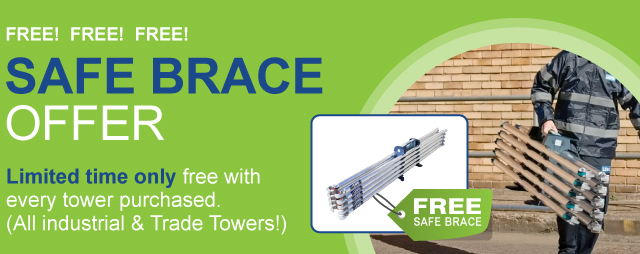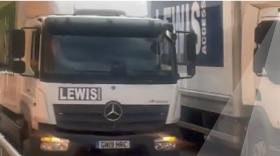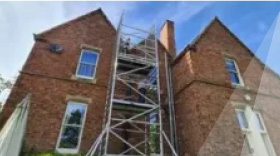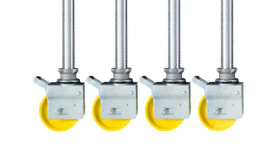Do you produce fibreglass ladders?
At this moment, we don’t produce fibreglass ladders.
How do you set up an extension ladder?
An extension ladder requires leaning against a wall to support you as you climb. To use it safely, you should ensure the ground is stable, and the ladder is firmly in place.
What is an extension ladder?
An extension ladder consists of two or more sliding sections that can be extended and locked into place to reach higher elevations. It is designed to provide access to areas that are out of reach for standard or step ladders. Each sliding section allows the user to adjust the intended working height.
What ladder height will I need to reach my gutters?
If you live in a bungalow, in other words, a single-storey home, you can reach your gutters with a 3-metre ladder. 2 or 3-storey houses will require an extension ladder that can reach six or 7-metres or more.
What is the tallest extension ladder available?
Our tallest extension ladder reaches a height of 10 metres.
Do you manufacture and stock telescopic ladders?
At this moment, we don’t manufacture or stock telescopic ladders.
What is a scaffold tower?
A tower scaffold a free-standing working platform that can be used to work more safely at various heights. The erection and dismantling of mobile access towers must be carried out by trained people who are competent in carrying out these important tasks.
Can anyone use a scaffold tower?
A tower scaffold can be assembled by a competently trained person after a risk assessment has been done and then signed off. Additionally, a pre-use inspection must be carried out before any person starts to work at a height on the tower.
Can anyone build a scaffold tower?
The quick answer is no! To build or erect a scaffold tower safely and correctly, people who are trained competently should only be allowed to do so. People using tower scaffolds, also known as mobile access towers, need to be properly trained in all aspects of erecting, dismantling and working on towers.
Can anyone erect a scaffold tower?
It is essential to ensure that a qualified and licensed mobile scaffolder handles the erection, adjustment, and dismantling of a scaffold tower. This is especially the case if there’s a risk that any person or object could potentially fall four or more meters from either the platform or the structure. But that doesn’t mean anyone can erect if the height is less than 4 meters. This is a guideline, which is why it’s essential to engage a qualified technician for scaffold tower erection.
Are scaffold towers safe?
In short, scaffold towers are safe, but they have maximum load weights like ladders. So, make sure you know that load to ensure the tower doesn’t take more people, equipment, or material to exceed the capacity of the ladder designed to support it.
While equipment and gadgets can be used on the scaffold tower, materials and equipment should not be stored there for long periods. Loading the tower for such can potentially weaken the platform.
Investing in a high-quality scaffold tower is a safer option than buying a cheap one. So, if you are entrusting your life to it, never settle for a budget product.
Although scaffold towers are sturdier and more stable than ladders alone, this doesn’t mean they can tolerate excessive deliberate movements. So, try to limit their exposure to sudden impacts, such as jumping up and down or dropping heavy objects onto them.
How big is a scaffold tower?
Scaffold towers are available in various sizes, which users choose according to the work they need to do. The taller the scaffold tower is the more expensive it will be. Scaffold towers range from three to seven metres. They can be configured in various ways. Be sure to read the instructions and safety information carefully.
How high can a scaffold tower go?
While using a scaffold tower, you always wonder about its maximum height. A scaffold tower built with typical components can achieve a maximum height of around 10 to 12 meters. But many DIYers and even professional tradesmen are confused about the terms “platform height” and “working height.”
Both terms are commonly used in scaffold towers.
The platform height refers to the height at which the platform can be raised. In other words, platform height is the vertical distance between the platform and the ground.
Conversely, working height is the height a person can safely reach while standing on the platform. Scaffold towers are available in various heights from 0.6 meters to 12 meters.
How tall a scaffold tower do I need?
When choosing a scaffold tower, height is also an important consideration, along with many other factors. It would help if you determined the work height to choose the height. To ensure a safe working environment, you must ensure that the worksite is well within the arm’s reach of the working person. A scaffold tower of 6 m and 7 m height works best for most two-story homes as a general guide.
Can I increase or change the height of the scaffold towers?
You can purchase additional sections and components to increase or change the height of your towers. We manufacture and supply every component and part of the equipment. However, we don’t recommend building towers higher than those in the instruction manual. If you need a tower for complex spaces, you need a written risk assessment issued by a competent scaffold tower expert. So, it is best to convey your requirements and buy a tower with the design and parameters which suit your needs better.
Do you need a harness on the scaffold tower?
So, while you’re a DIYer, you might wonder if falling from the scaffold tower is risky. Well, if you’re using a high-quality scaffold tower with all protection components like guard rails, kickboards, outriggers, and internal ladders, then there’s no need for a harness. Apart from that, you must still follow standard safety requirements like wearing a hard hat, using a high-visibility jacket and keeping tools and materials organised on site.
Can you use scaffolding on a slope or uneven ground?
Typical mobile scaffold towers with adjustable wheels are not recommended for surfaces with a slope exceeding 5 degrees. The scaffold tower without flexible components can only be established on level, firm and stable ground, and you need to support the feet or wheels of the tower.
However, scaffold towers with adjustable legs can be used on uneven heights or un-level ground. The supporting components must be adjusted and secured tightly according to the area’s terrain. You must always keep the brakes locked on the wheel unless transporting the system from one site to another.
What makes LEWIS Scaffold towers different than other industrial scaffold towers?
We take safety and efficiency seriously. We provide scaffold towers in compliance with current legislation. We hold a BSI Kitemark that shows the quality and safety of products. Our scaffold towers have been manufactured to the highest quality.
Do you guide on best practices and procedures regarding scaffold towers?
Yeah, absolutely! We have our in-house health and safety officer. Whether you’re worried about the type of scaffold tower best for your industrial project or need guidance on best practices and procedures, we’re here to answer.
What scaffold tower would be best for my industry?
Choosing the right product seems overwhelming, with various scaffold towers available for different industries.
As safety comes first, you must choose a product certified and tested by British Standards Kitemarks.
If you are offered a product with the mark “CE Mark”, it shows that the product has been shipped into the UK from outside of Europe, usually China.
The next important thing to look for is the manufacturing location.
Don’t fall for false claims and logos named “Made in Britain”, as 9 out of 10 won’t pass the British Standard Test.
A high-quality scaffold tower company always offers detailed specifications and product limitations.
Will my business need a certified scaffold tower?
You can’t use a DIY or SDIY scaffold tower for industrial use. You need a scaffold tower that has complete certifications as Working At Height Regulations (WAHR) do apply to all businesses. As a BSI Kitemark holder, our industrial and trade scaffold towers fully satisfy HSE and safety regulations.
Do aluminium scaffold towers rust? Can I store it outside?
All of our industrial scaffold towers are manufactured of high-grade aluminium, which makes them sturdy and durable towers. With our high-quality coating, there’s no question that rusting will take place. But as you’re investing in a new scaffold tower, we recommend storing it indoors as it’ll wear out quicker in wet conditions.
What width is of the single-width and double-width?
Our single-width towers are 900 mm externally, while the double-width towers are 1500 mm externally. Single-width towers come with one working platform per level while double-width comes with two platforms per level. Both can be erected up to 12 meters of working height.
What do you mean by “working height” in connection with your scaffold tower sizes? What is the difference between “working height” and “platform height”?
The term “platform height” refers to the height of the tower, i.e., the height at which you can physically stand on it.
“Working height”, on the other hand, is the estimated reach based on the person using the equipment.
The working height is defined as 2 m above the platform height. It is a standard practice in the access industry. This standard will help you to compare different products and get the right one for your needs without engaging in dangerous solutions.
How long is your warranty period?
We won’t use false marketing slogans as “lifetime guarantee” or “lifetime warranty”, instead we have our products fully backed by limited time “insurance backed guarantee”. That means if you have any issues later with the product, you can claim directly from the insurance company on the certificate.
If you have any issue with the scaffold tower, we’re just a phone call away. We provide lifetime support. We offer 100% satisfaction to our customers, before, during, and after you have purchased.




